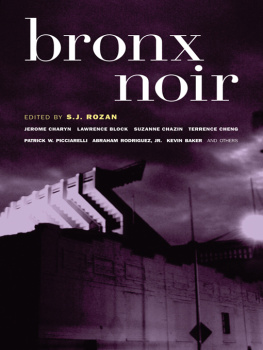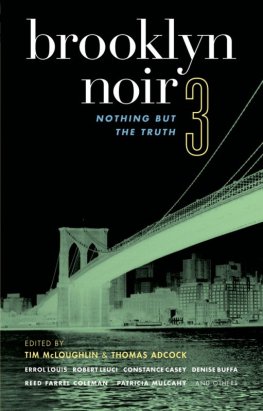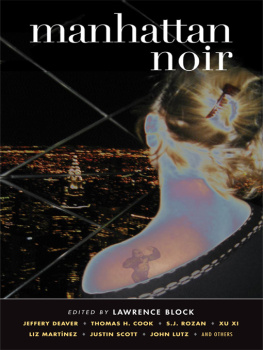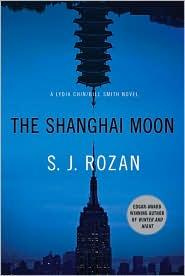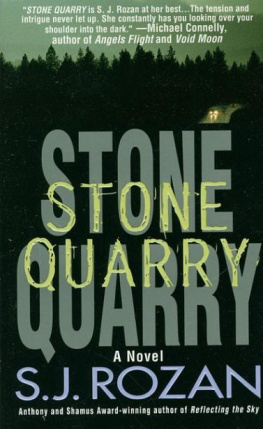This collection is comprised of works of fiction. All names, characters, places, and incidents are the product of the authors imaginations. Any resemblance to real events or persons, living or dead, is entirely coincidental.
Published by Akashic Books
2007 Akashic Books
Series concept by Tim McLoughlin and Johnny Temple
Bronx map by Sohrab Habibion
ePub ISBN-13: 978-1-936-07022-0
ISBN-13: 978-1-933354-25-5
Library of Congress Control Number: 2006936535
All rights reserved
First printing
Akashic Books
PO Box 1456
New York, NY 10009
info@akashicbooks.com
www.akashicbooks.com
ALSO IN THE AKASHIC NOIR SERIES:
Baltimore Noir, edited by Laura Lippman
Brooklyn Noir, edited by Tim McLoughlin
Brooklyn Noir 2: The Classics, edited by Tim McLoughliny
Chicago Noir, edited by Neal Pollack
D.C. Noir, edited by George Pelecanos
Dublin Noir, edited by Ken Bruen
London Noir, edited by Cathi Unsworth
Los Angeles Noir, edited by Denise Hamilton
Manhattan Noir, edited by Lawrence Block
Miami Noir, edited by Les Standiford
New Orleans Noir, edited by Julie Smith
San Francisco Noir, edited by Peter Maravelis
Twin Cities Noir, edited by Julie Schaper & Steven Horwitz
Wall Street Noir, edited by Peter Spiegelman
FORTHCOMING:
Brooklyn Noir 3, edited by Tim McLoughlin & Thomas Adcock
D.C. Noir 2: The Classics, edited by George Pelecanos
Delhi Noir (India), edited by Hirsh Sawhney
Detroit Noir, edited by E.J. Olsen & John C. Hocking
Havana Noir (Cuba), edited by Achy Obejas
Istanbul Noir (Turkey), edited by Mustafa Ziyalan & Amy Spangler
Lagos Noir (Nigeria), edited by Chris Abani
Las Vegas Noir, edited by Jarret Keene & Todd James Pierce
Paris Noir (France), edited by Aurlien Masson
Queens Noir, edited by Robert Knightly
Rome Noir (Italy), edited by Chiara Stangalino & Maxim Jakubowski
Toronto Noir (Canada), edited by Janine Armin & Nathaniel G. Moore
With great admiration, the editor dedicates this book to
Grace Paley, whose childhood in the Bronx was happy.
WELCOME TO DA BRONX
T he Bronx is a wonderful place.
Wonderful in the literal sense: full of wonders. Wonders everyones heard of, like the Bronx Zoo and Yankee Stadium; wonders that make presidents cry, as Jimmy Carter famously did in 1977, standing in the rubble of the South Bronx; and wonders only we Bronxites seem to know about, like Wave Hill, City Island, and Arthur Avenue.
People are always discovering the Bronx. Native Americans, of course, discovered it first, fishing and hunting in its woods and streams long before Europe discovered the New World. The first European to settle north of the Harlem River was one Jonas Bronck, in 1639. Jonas and his family worked part of his huge swath of land and leased the rest to other farmers. Everyone in the area gave their address as the Broncks farm, giving rise to the the and eventually the x. (Therewere giving you not only great stories, but a party trick fact.) And development and industrialization, sparked by the railroad in the early 1840s, probably took care of the farm.
In 1895, New York City discovered the Bronx, and Westchester discovered it didnt own the place anymore. In 1914, New York State discovered it needed a sixty-second county, and Bronx County was born.
Immigrants discovered the Bronx in waves. Germans, Italians, and Irish came early, and then European Jews. The Grand Concourse, modeled on the Champs-lyses in Paris, was built to draw them northward. In the 1960s, as the second and third generations of those immigrants moved to the suburbs, Puerto Ricans and blacks took their places. Now theyre being joined by Latinos from all over Central and South America, Caribbean islanders, Eastern Europeans, Africans, Asians, and, of course, yuppies. Sooner or later, everyone discovers the Bronx.
Parts of the Bronx suffered badly from the governmental anti-urbanism and heavy-handed city planning of the 50s and 60s, and to a lot of people the Bronx became another term for urban decay. Twas never true. Though the worst America has to offer its poorer citizens can be found in some areas of the Bronxthis is what brought Jimmy Carter to tearsgreat stretches are what theyve always been: neighborhoods of working-class people, native-born and immigrants, looking for a break. And there were two-family row houses along Sedgwick Avenue, mansions in Riverdale, and fishing boats sailing out from City Island before, during, and after the filming of Fort Apache, The Bronx. (A personal note: In my previous life as an architect, my firm did the new building for the 41st Precinct, which had been Fort Apache until the city clear-cut the blocks around it and the NYPD started calling it Little House on the Prairie.)
If you want to discover the Bronx yourself, you might go up to Van Cortlandt Park to watch white-uniformed West Indians playing cricket on the emerald grass. Theyre there most summer Sundays, just north of the swimming pool, south of a rowdy soccer game, west of the riding stable, and east of the elevated subway that runs along Broadway. That subway linethe Number 1, by the way, and need I say more?ends there, at 242nd Street, but the Bronx goes on for another mile. Or you might try the Botanical Garden, the Zoo, the House That Ruth BuiltYankee Stadium, for you tinhornsor the new Antiques Row just over the Third Avenue Bridge. These are all terrific destinations, but the real discovery will be the size of the place and the diversity of the lives youll glimpse as you pass through.
And in this wondrous Bronx, the exceptional writers in this collection have found noir corners, dark moments, and rich places of astonishing variety. You cant pack so much yearning, so many people, such a range of everythingincome, ethnicity, occupation, land useinto a single borough, even one as big as the Bronx, and not force the kind of friction that slices and sparks. The Bronx has been home to big-time gangstersfrom the Jewish organized crime of Murder Inc. and the Italian Cosa Nostra to the equally organized drug-dealing gangstas of today. The Third Avenue El was a Hopperesque symbol of urban hopelessness; its been demolished, but trains on other lines still rumble through the roofscapes of the borough. Prosperity is increasing and drug use is decreasing, but the public housing projects in the Bronx are some of the nations largest and remain some of its toughest. Many places in the Bronx seem hidden in shadows, just as the Bronx itself is in Manhattans shadow. And dark stories develop best in shadows.
From Abraham Rodriguez, Jr.s South Bronx to Robert Hughess Fordham Road, from Joseph Wallaces Bronx Zoo to Terrence Chengs Lehman College, from Joanne Dobsons postWWII Sedgwick Avenue to Lawrence Blocks new waveyuppie Riverdale, its all here. In this book, we offer a hint of the cultural, social, economic, and geographic range of the only New York City borough on the mainland of North America. Ladies and gentlemen, welcome to Da Bronx.
S.J. Rozan
The Bronx
June 2007
P rudence had escaped from the womens farm in Milledgeville and gone on a crime spree. She murdered six men and a woman, robbed nine McDonalds and seven Home Depots in different states. She wore a neckerchief gathered under her eyes and carried a silver Colt that was more like an heirloom than a good, reliable gun. The Colt had exploded in her face during one of the robberies at McDonalds, but she still managed to collect the cash, and her own willfulness wouldnt allow her to get a new gun.
Next page
